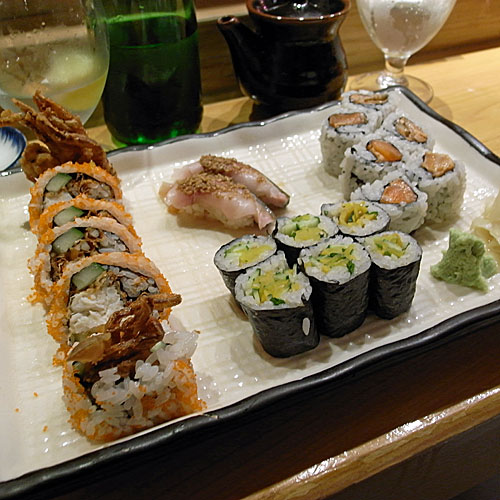Where’s my flux capacitor when I need it? We all live in the past to some extent, but a recent episode of dining in New York City with Professor N reaffirmed that we sometimes eat in the past too.
First, we decided on the basis of a review in New York Magazine to dine at Mainland, a Chinese place on the upper east side. Knowing that the NYC restaurant scene can be turbulent, I called for a reservation. A woman with a thick accent in a noisy room picked up the phone and took my details. When we showed up at the address, there was no sign of Mainland. Instead of a hot and loud chinese place, there was a cool and louder Italian one, Accademia di Vino. Same address, same phone number. Oops.
Consulting our mobile internets, we decided to check out a nearby sushi place called Sushihatsu. We arrived there and proceeded to read the New York Times review by Eric Asimov posted in the window, which began,
LIKE traffic at rush hour, decent sushi is no surprise. It’s there and you accept it. Great sushi is another matter, as rare as a memorable turkey on Thanksgiving. When you find it you treasure it, which is why I was so sad to learn earlier this year that Sushihatsu had closed.
Closed?? But we’re right here reading the review! Despite the fact that Asimov devotes easily 30% of his review to the former establishment, the place is now in fact Sushi Seki and is declared a worthy successor. We entered, dined and enjoyed ourselves, especially the horse mackerel and seared salmon. Also pictured, soft shell crab maki and pickle maki.

Later on in the week, we have a craving for thin-crust pizza and get a tip to try Company in Chelsea. Despite the trendy overlay, the place is said to have a 900-degree oven, and that bodes well for thin-crust pizza.
True to its hip Chelsea vibe, we were assigned a pretty waiter who is bored with our existence and petty ordering. After three tries, we got a nice housemade lemon soda and eventually a classic Margherita and something called the Popeye which is a bianco style pizza with generous spinach on it. As advertised, the crusts are ultra-thin and very crisp.
So crisp, in fact, that a diner at a neighboring table sent back part of her pizza because it was burnt. Sensing the eyes of fellow diners upon her, she protested a bit too loudly, “what? It’s carcinogenic!” which does little to impress our waiter. The customer is always right, but honestly, I think the charred bits are part of the fun with thin crust pizza, especially in a wood-fired oven. (and, I’m pretty sure the cancer risk is very low for meat char (see myth #4) and zero for vegetarian char)
When Prof. N returned home and regales his sister with the story of our rude waiter, she replies with, “oh, you should have gone to Accademia di Vino, they have great pizza.”

Mmmm mmmmm good. After you left, I also went to Artichoke Basille’s, where I waited 30 minutes for a very good slice: loved the Margherita, hated the famous artichoke and spinach – it tasted like a big spinach dip on a slice.
On a different night I also went to Sripraphai a different night for the best Thai food I’ve ever had.
Basically that was a very good week for food, and now I need new pants.
I’m so jealous you got to try Company! It’s high on my list of places I want to try during my next trip to NYC. I *love* the pizzas produced at the former Sullivan Street Bakery, which is now called Grandaisy Bakery. It’s under new ownership, but their breads and pizzas taste exactly the same as when Lahey ran the place. I am particularly fond of the patate: http://www.grandaisybakery.com/pizza_patate.html and the zuchini:
http://www.grandaisybakery.com/pizza_zuchini.html. I have no doubt that the Company pizzas are very different from the Sullivan Street/Grandaisy pizzas, but I’m itching to visit the place. I also noticed a ribolita on the menu at Company that I hope is vegetarian because I’d love to try it.
PS: If you ever visit Grandaisy, be sure to grab a bag or two of their ossi di morte:
http://www.grandaisybakery.com/biscotti_ossidimorte.html